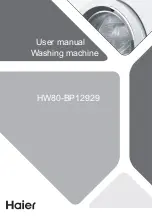
END OF USE AND WINTER STORAGE INSTRUCTIONS
PUMP
The manufacturer recommends using
a pump protector/winterizer when
storing the unit for more than 30 days
and/or when freezing temperatures
are expected. Pump protector/winter-
izer is available at the store where the
pressure washer was purchased. If a
pump protector/winterizer is not avail-
able, RV antifreeze needs to be run
through the pump as outlined in the
steps below.
NOTE: Using a pump protector/
winterizer or RV antifreeze is to pro-
vide proper lubrication to the internal
seals of the pump regardless of tem-
perature or environment.
1. Obtain a funnel, 6 oz. (170 mL)
of RV antifreeze and 16–36"
(40–91cm) of garden hose with a
male hose connector attached to
one end.
Risk of property
damage. Use only
RV antifreeze. Any other antifreeze
is corrosive and can damage pump.
2.
Disconnect spark plug wire.
3.
Connect length of garden hose to
water inlet of pump.
4.
Add RV antifreeze to hose as
shown.
5.
Pull engine starter rope slowly
several times until antifreeze
comes out of high-pressure hose
connection of pump.
6.
Remove garden hose from water
inlet of pump.
7.
Reconnect spark plug wire.
30
PRESSURE WASHER
1. Drain all water from high pres-
sure hose, coil it, and store it
in cradle of the pressure washer
handle.
2. Drain all water from spray gun
and wand by holding spray gun in
a vertical position with nozzle end
pointing down and squeezing trig-
ger. Store in gun holder.
3. Store chemical hose so it is pro-
tected from damage.
ENGINE
Storage Preparation
Proper storage preparation is essential for keeping your engine trouble free and looking good.
The following steps will help to keep rust and corrosion from impairing your engine’s function and
appearance, and will make the engine easier to start after storage.
Cleaning
If the engine has been running, allow it to cool for at least half an hour before cleaning. Clean all
exterior surfaces, touch up any damaged paint, and coat other areas that may rust with a light
film of oil.
CAUTION:
Using a garden hose or pressure washing equipment can force water into
the air cleaner or muffler opening. Water in the air cleaner will soak the air filter, and water that
passes through the air filter or muffler can enter the cylinder, causing damage.
Water contacting a hot engine can cause damage. If the engine has been running, allow it to cool
for at least half an hour before washing.
The gap should be 0.028 - 0.031 in (0.70 - 0.80 mm). Correct
the gap, if necessary, by carefully bending the side electrode.
5. Install the spark plug carefully, by hand, to avoid cross-threading.
6. After the spark plug seats, tighten with a spark plug wrench to compress the gasket.
If reinstalling the used spark plug, tighten 1/8 - 1/4 turn after the spark plug seats.
If installing a new spark plug, tighten 1/2 turn after the spark plug seats.
CAUTION:
A loose spark plug can overheat and damage the engine.
Over tightening the spark plug can damage the threads in the cylinder head.
7. Attach the spark plug cap.
















































